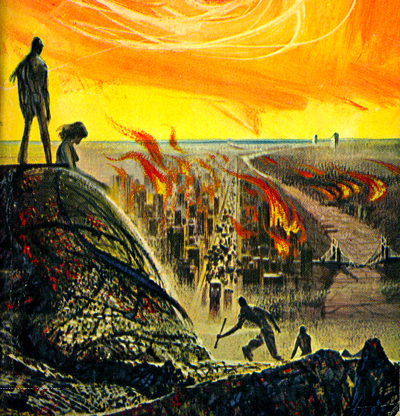2050-
Natural gas depleted, Russia
15% of the world’s biodiversity extinct.
Atlantic Republic invades Canada’s province of Quebec to try and claim the hydroelectric projects that lie there.
Failure of southeastern European states completes with the fall of Bulgaria and Poland.
Growing Islamic influence in Italy and the Mediterranean basin due to relative successes of the Maghreb Union and Turkey and the relative failure of the European states leads to restructuring of the Papacy and more active local missionary work. For the most part this is most successful amongst the desperate suffering masses of the irradiated lands of southern France and northwestern Italy.
The Confederate States of America withdraws from Guyana after conducting ‘cost-benefit’ analysis of war. Former Guyana, Suriname and Guyenne territories join Amazonia.
2051-
Deindustrialization, Russia and Canada
Papua New Guinea (now the kingdom of Tok Pisin) invades western Papua, scattered western islands, forcibly exiling Muslims and obvious foreigners and enforces a cultural hegemony.
Father Remirez founds the Church of the One True Light in southern Bolivia.
New Day Movement founded.
Naxalite Maoist begin rebuilding Indian nuclear wastelands of Andra Pradesh and parts of Orissa, Chattisgarh, Arnataka and Kaharashtra, form new communist nation of Naxal.
2052-
Influenza pandemic sweeps globe, kills hundreds of millions.
French government fails, amid pandemic, storms and severe winters on their northern coasts, failure of their industry and droughts in the south. Decentralized French authority resembles nothing so much as independent medieval fiefdoms.
Nascent state of Jiangnan, a military dictatorship, established in the heavily damaged provinces of Taiwan, Jiangsu and Zhejiang.
2053-
Decentralization in the face of de-industrialization leads to many break-away warlords amongst the ASEAN United Six. AU6 declares martial law.
Germany follows France into feuding medieval fiefdoms.
The Spiegal corporation seizes thorium nuclear reactors and munitions factories in southern and central german during the resultant chaos, maintaining the otherwise defunct German army and preventing wide-scale banditry and the rise of warlords.
2054-
Ecuadorian villages and towns, without real federal leadership or national identity are peacefully annexed by Colombian Communist
2055-
The AU6 adopts a permanent police state government to control splintering and coups by would-be warlords.
Confederate Communalist Ecology movement, inspired by the writings of Murray Bookchin, popularizes in Britain and Scandinavia.
South African military dictatorship unable to maintain centralizing rule of massive territories. Popular uprising disposes of the government and does not replace it.
Australian executive government positions declared hereditary.
2056-
Italy, Croatia, Albania, Greece and other Mediterranean powers continue to suffer as drought repeatedly strikes at the Mediterranean basin. Without the major solar projects of Iberia or the Maghreb Union, they are ill-suited to prevent the desertification of their territories or the fragmentation of their societies. Minor principalities, each with their own mostly-feudal townships and supporting lands and fishing fleets inherit.
Australia invades decentralized New Zealand.
AU6 wrestles Hainan from local warlords.
2057-
Lowland Rio de Janeiro abandoned to rising seas.
Brazilian federal military, facing desertion and lack of leadership in a nation now nearly completely decentralized, seizes, with Canadian backing, government power and signs a far-reaching agreement with Canada exchanging energy, industrial and technical assistance for Brazilian cheaply accessible thorium deposits.
2058-
Oil depleted, world
Adelaide abandoned to rising seas.
Canadians homesteaders, desperate for energy to fuel their remaining industries turn to burning forests for charcoal.
Scandinavian communities, largely decentralized and no longer recognizing central authority from Norway, Sweden, or Finland, unite under the Confederate Communalist Union.
Much of Gascogne and Languedoc annexed by technically and energy-rich Iberian military dictatorship.
French nobles of other Southwestern French provinces unite to form the ‘Frankish Council’ and provide support and united resistance against Iberian territorial aggression.
2059-
British Colombia, ignoring Canadian federal laws, outlaws deforestation practices. Canada initiates ‘martial law’ in rebellious province. Cascadia sneaks supplies to the BC rebels.
Heartland Union ceases food aid of Atlantic Republic.
Offshore Southeastern Asian states, fearful of AU6 and with support from the Ummat Al-Mu’minin unites Indonesia, Malaysia, Brunei, reforming as the Pacific Island Sultanate.
Turkey invades north-west coast of the Black Sea region, citing hardship of the people and their missions there.
Brazilian military dictatorship, in an economic model based on Canada’s, institutes slavery and ‘modernization‘ of its military structure.
New Zealand Communalist Ecological Movement makes first series of attacks on occupying Australian forces.
2060-
Karachi abandoned to rising seas.
After nearly ten years of slow attrition and massive damage to the Quebecois hydroelectric system in which more and more Quebec natives fought both sides in an effort to reclaim their own identity, a peace is signed between Canada and the Atlantic Republic with some small scale territorial reshuffling and the province of Quebec gaining autonomy.
British counties admitted to the Confederate Communalist Union.
After extended suffering, the heavily irradiated and massively damaged Indian west coast and the provinces of Gujarat, Maharashtra, and western Karnataka form the nation of Naraka (a reference to Hindu hell). The inhabitants are desperate creatures who truly believe themselves to be living in hell (they may be right) and to have died (or their parents to have done so) in the nuclear wars of 2039. Cancer, childhood mortality and mutations and other opportunistic diseases are so common as to be considered the norm.
2061-
Amazon river fails.
Canada, still smarting from its efforts in Quebec, is held off by fanatical British Colombian irregulars operating in the rocky mountain interiors and supported by Cascadia.
Negotiations regarding union of Heartland and Quebec fizzle out despite agricultural and financial support for the secretive terrorists within Quebec by the Heartland Union.
Much of the southwestern Balkan regions annexed by Ankara.
Horse-based power, calling themselves the Zaporizhian on the rise in Ukrainian plains, uniting diverse anarchist ‘tribes’.
Amazonian homesteaders, faced with increasing desertification of the Amazon basin begin crossing the border into Brazil to harvest timber for fuel and construction material. Brazil responds by militarizing the border.
Military coup backed by unidentified sponsors initiates civil war in Caribbean Commune.
2062-
British Colombia joins Cascadia.
Estonian-Russia resistance movement to join the Confederate Communalist Union is brutally squashed by Russia.
Georgia attempts secession from Russia and receives military and economic assistance from Armenian Apostolic theocracy.
Brazil invades decentralized region of Bolivia.
After extended civil and foreign military involvement, including repulsing attacks by the Blue Suns Corp, and the Liangshan Yi, the recovering Chinese province of Szechuan is united under a military junta and formalizes as a national entity.
Organized and well-armed Bantu warlords begin appearing amongst the scattered deindustrialized tribes of what was once the Congo, Zaire, and Angolia and rapidly begin developing a hydro-electric based energy economy on a model similar to that of Colombia or Quebec.
2063-
Minor Croation principalities begin to be unified under Prince Đuro Grulović, who would be king. Albanian and south Croatian principalities, with Turkish support, unite in an Adriatic Principalities Confederation to successfully resist his military expansion and free many of the annexed principalities.
Brazil invades decentralized region of Paraguay.
Brazil invades decentralized region of Uruguay.
2064-
Zaphorizhian horsemen expand westwards as far as Hungary and Poland, comes into conflict with the Austrian and Polish fiefdoms.
Colombia provides emergency economic, military and technical aid to Chile and Peruvian regions, assisting in the development of a central authority based on hydro-electric power (in a model similar to that of Colombia itself)
South African, Namibian and Botswanan people unite under charismatic and energetic leader and found the Khoisan Kingdom.
Ummat Al-Mu’minin annexes territory of former northern Sudan, northern Ethiopia, and Somalian coast with little resistance.
2065-
Mongolian Khanate invades southern portions of inner Mongolia not claimed by Manchuria and parts of the Xiajiang province, establishing greatly expanded territorial boundaries at the expense of local disorganized warlords.
Tamil uprising in Sri Lanka.
Civil war in Caribbean ends with decisive victory, with Colombian support, for the communist powers.
2066-
British isles largely united with Scandinavia as part of the Confederate Communalist Union.
Georgian-Russian-Armenian war ends with Georgia seceding to Armenian Apostolic Theocracy.
Infighting and civil war within the Bantu warlords eventually leads to victory for one military alliance over others and the formation of the state of Bantu Ubuntu.
2067-
Entirety of the Amazon River succumbs to desertification.
A Brazilian/Canadian sponsored military coup in Peru topples the local government and places into power a military dictatorship friendly to Brazil and Canada and which quickly instates a policy of slavery.
2068-
A Brazilian/Peruvian sponsored military coup in the Andean Commune (Chile) fails in the face of organized central resistance and Colombian military and technical assistance.
New Day Movement defeats Kenyan army at the battle of Ruiru, establishes a territorial state in center-east Africa.
2069-
New Day Movement inherits the East African Community intergovernmental organization from Burundi, Kenyan, Rwanda, Tanzania and Ugandan territories not associated with the growing Islamic Makua Islamic state.
2070-
Makua Islamic state, Makuata, with support from the Maghreb union and utilizing extensive hydro-electric power developed in conjunction with the Bantu Ubuntu born in South-Eastern Africa.
New Day Movement founds the nation of Tukufu Tanganyika.
2071-
Polar methane hydrates peak.
Christian rebel movement in northwestern Ummat Al-Mu’minin in favor of secessionism to the Armenian Apostolic Theocracy launches bomb attacks on Ummat Al-Mu’minin cities causing major damage and many deaths.
Brazil invades decentralized region of Argentina only to find a popular resistance based on the Church of Universal Light ready for them.
Zealand-Australian accord recognizes Zealand Communalists as independent of Australia.
2072-
Adriatic Principalities Confederation expands to include much of eastern Italy, Albania, and western Greece. Turkish and Maghreb Union financial support and cultural influence has Islamacized many of the principalities.
Pacific Island Sultanate, under continued influence of the Ummat Al-Mu’minin, adopts Shia Islam as a national religion.
2073-
Dublin abandoned to rising seas.
Nahuatl-speaking fighters appear in the mountains of México and central America, quickly seizing the remnants of major cities across former México and central America and unite the people under the new nation of Azteca
2075-
Polar methane hydrates depleted, Russia
Increasingly brutual border tactics and slave raids by the Brazilians upon dessertified Amazonia leads to its declaration of war against Brazil and coordinated attacks by both the Church of Universal Light and Amazonia upon Brazil.
Tamils manage to overthrow federal Sinhalese-based government of Sri Lanka; state renamed Eezham.
Australia invades Tok Pisin islands.
2076-
Northern European monarchy rises to unite German, Polish and other north European fiefdoms; founding the New Prussian Kingdom
2077-
Adriatic Principalities Confederation renamed the Mediterranean Principalities Confederation as much of the remaining Italian and Greek lands fall under its union.
Bantu Ubuntu warlords step down and population elects a representative senate and prime minister, forming a parliamentary democracy.
Tok-Pisin-Australian accord agrees to white peace between the Aussies and Tok Pisin.
2078-
Austria, in a model based on the Prussian one, and with assistance from the Spiegal corporation, establishes a monarchy, uniting its military, temporarily, with the Prussian one to fight off the Zaphorizhian horsemen.
‘Amazonian shakes’ pandemic sweeps globe.
Polar methane hydrates depleted, Canada
Papacy and their protectorate amongst the irradiated lands respond to formation of the Mediterranean Principalities Confederation with an official declaration of union and the formation of the Mefitis Catholic Theocracy
War between Brazil and The Church of Universal Light comes to a close with the Church gaining numerous concessions from Brazil including their right to self-governance a large territorial division of Paraguay, Argentina and Uruguay. The church held lands are renamed Pampasna after the central agricultural plains forming the basis for their agricultural wealth.
Peace signed between Amazonia and Brazil
2079-
Collegiate combine movement seizes power in Cascadia in a bloody coup backed by religious technocrats.
Diverse and divided northern ‘Frankish nobles’ unite with south in the face of Prussian territorial aggression. Frankish-Prussian war ensues.
Zaphorizhian Republic officially recognized, signs peace with the Prussian and Austrian kingdoms.
2080-
World population reaches its lowest levels in four hundred years (~750 million).
End of worldwide economic contraction and slight beginning of recovery
2081-
London abandoned to rising seas.
Communist-based revolution in the Pampasna fails.
2083-
Military coup backed by Brazil fails in Pampasna.
Popular socialist rebellion in Iberia wages war on established military structure in Iberian civil war.
2084-
French council of nobles sign disadvantageous peace with Prussian kingdom. French plutocracy of ‘Frankish Principalities’ founded.
2082-
Popular socialist coup topples Iberian military junta and establishes communist rule. French assistance leads to minor territorial concessions by Iberia to the ‘Frankish Principalities’.
2088-
Communist-based coup in Peru fails in the face of brutal oppression by technically-sophisticated ‘death-squads’.
2096-
A series of three successive hurricanes strike Cascadia, greatly reducing Victoria island and merchant and fishing fleets.
2100-
50% of the world’s biodiversity extinct.










